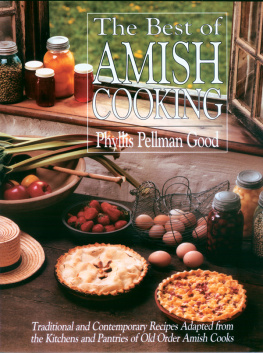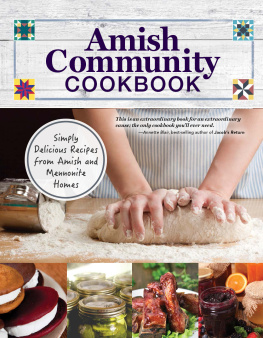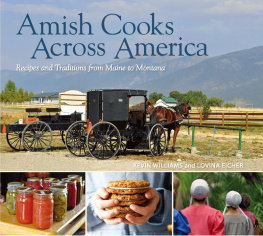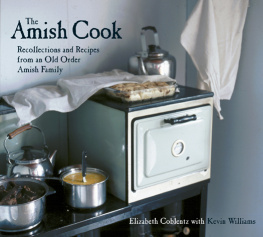Acknowledgments and Credits Many Old Order Amish friends and acquaintances delved into their memories and recipe boxes to answer hours of my questions. There is always work to be done, yet these folks sat patiently at their kitchen tables or on nearby sofas while I gathered facts, impressions, and recipes. I am deeply grateful. Still other friends provided the setting for photography in their kitchens and basements. The Hans Herr House, the oldest remaining dwelling in Lancaster County, built in 1719 by a Mennonite leader, graciously allowed us to photograph the cover and several other shots on that property. Thank you all.
Copyright 2014 by Phyllis Pellman Good All rights reserved. No part of this book may be reproduced in any manner without the express written consent of the publisher, except in the case of brief excerpts in critical reviews or articles. All inquiries should be addressed to Good Books, 307 West 36th Street, 11th Floor, New York, NY 10018. Good Books books may be purchased in bulk at special discounts for sales promotion, corporate gifts, fund-raising, or educational purposes. Special editions can also be created to specifications. For details, contact the Special Sales Department, Good Books, 307 West 36th Street, 11th Floor, New York, NY 10018 or info@skyhorsepublishing.com.
Good Books in an imprint of Skyhorse Publishing, Inc., a Delaware corporation. Visit our website at www.goodbooks.com. 10 9 8 7 6 5 4 3 2 1 Library of Congress Cataloging-in-Publication Data is available on file. Design by Dawn J. Ranck Photography design by Kenneth Pellman Photography by Jonathan Charles Print ISBN: 978-1-56148-407-5 (paperback edition) 978-1-56148-408-3 (comb-bound paperback edition) 978-1-56148-330-3 (spiral edition) Ebook ISBN: 9781680990362 Printed in the United States of America Library of Congress Cataloging-in-Publication Data Good, Phyllis Pellman The best of Amish cooking. Bibliography: p.
Includes index. 1. Cookery, Amish. 2. CookeryPennsylvania. Title.
| TX715.G647 1988 641.5088287 | 88-82138 |
Table of Contents An Introduction to the Amish and Their Food The Amish have captured the interest of the modern world because of their quaint clothing, homes, and buggies, their striking quilts, their lusty food.
| TX715.G647 1988 641.5088287 | 88-82138 |
Table of Contents An Introduction to the Amish and Their Food The Amish have captured the interest of the modern world because of their quaint clothing, homes, and buggies, their striking quilts, their lusty food.
These people prefer to be regarded as a community of faith who deliberately seek to live in a way that honors God and the creation. They purposely refuse many conveniences to better foster their life together; they choose to live close to the land in an effort to care for their families and the earth. Who Are These People? The Amish are a Christian group who trace their beginnings to the time of the Protestant Reformation in 16th century Europe. In 1525 a group of believers parted company with the established state church for a variety of reasons. Among them was the conviction that one must voluntarily become a follower of Christ, and that that deliberate decision will be reflected in all of ones life. Therefore, baptism must symbolize that choice.
The movement was nicknamed Anabaptists, meaning re-baptism, since the believers wanted to be baptized again as adults. Eventually the group were called Mennonites after Menno Simons, one of their leaders who had formerly been a Roman Catholic priest. Over the years these people grew into a strong faith community, concerned with the nurture and discipline of each other. Basic to their beliefs was a conviction that if one was a faithful follower of Christs, ones behavior would clearly distinguish one from the larger world. These people saw themselves as separated unto God because of their values of love, forgiveness, and peace. Because they were misunderstood and because they appeared to be a threat to the established church and government, the people were often persecuted and many became refugees.
In 1693, a magnetic young Mennonite leader believed that the church was losing some of its purity and that it was beginning to compromise with the world. And so he and a group who agreed with him left the Mennonites and formed a separate fellowship. They were called Amish, after their leader, Jacob Amman. Today the Amish identify themselves as the most conservative group of Mennonites. The movement which Amman began reached into Switzerland, Alsace, and the Palatinate area of Germany. As early as 1727 Amish families began to resettle in North America where they found farmland, space to live as neighbors to each other, and a climate that nurtured their growth as a church family with a distinctive lifestyle.
The tiny communities struggled to survive in the early years. As was true for other pioneers, the Amish invested most of their time and energy in clearing the land, establishing their homesteads, and getting along with the native Americans. Most of those who arrived from the 1720s through the mid-1760s settled in eastern Pennsylvania, yet they did not live in sequestered communities. Frequently they had neighbors who were not Amish. With that came the opportunity for interchange with folks from the larger world. Nor was the Amish church as defined in terms of distinctive practices nor as organized under recognized leaders as it became following the American Revolution.
That event crystallized many of the convictions these people held and united them in their refusal to join the War, since they were (and remain today) conscientious objectors. The Amish intend to give their primary attention and energy to being faithful disciples of the teachings of Jesus Christ. They believe they can do that best as members of a community who together share that desire. Consequently they have tried to withstand acculturation into the worldly society surrounding them. They have remained close to the land, preferring to farm if at all possible. They believe hard work is honorable, that church and family provide ones primary identity.
Their ideal in life is not to pursue careers that lead to prosperity and prestige, but to become responsible and contributing members to their faith community. The Amish have changed throughout their nearly 300 years of history. Their intent, however, is to be deliberate about change, to manage it carefully so that it does not erode their convictions. The Amish continue to grow. Today they live in 20 states and one Canadian province, totaling about 100,000 adults and children. There are twice as many Amish persons today as there were only 20 years ago.
They are a living and dynamic people. What Is Their Food Tradition in the New World? Because they are highly disciplined, the Amish are often perceived as being grim, austere folks who live as ascetics. They do live ordered lives and, in general, are restrained in their outward expression. But in two particular areas they have exercised colorin their quilts and in their food! In both areas they distinguished themselves only after becoming established in North America. By the mid-1850s and during the next several decades a food tradition evolved that included an amalgam of dishes from a variety of sources: they brought their own cultural taste preferences from Switzerland and Germany; that affected what they copied and adapted from the diets of their English and native American neighbors; the geography and climate in the area of the New World where they made their homes also shaped their eating. In those ways, however, they were little different from the other German folk who settled in William Penns colony.


















![Beverly M Lewis] - The Beverly Lewis Amish Heritage Cookbook](/uploads/posts/book/96304/thumbs/beverly-m-lewis-the-beverly-lewis-amish-heritage.jpg)


